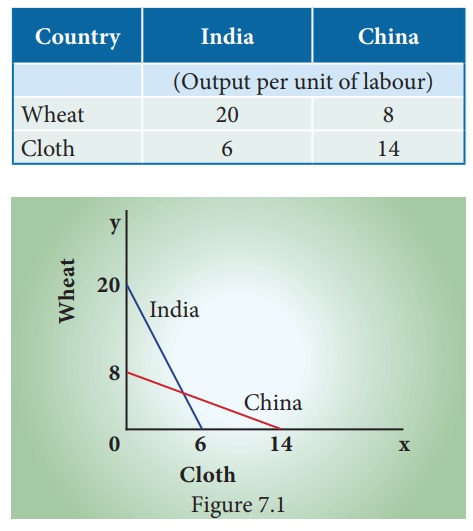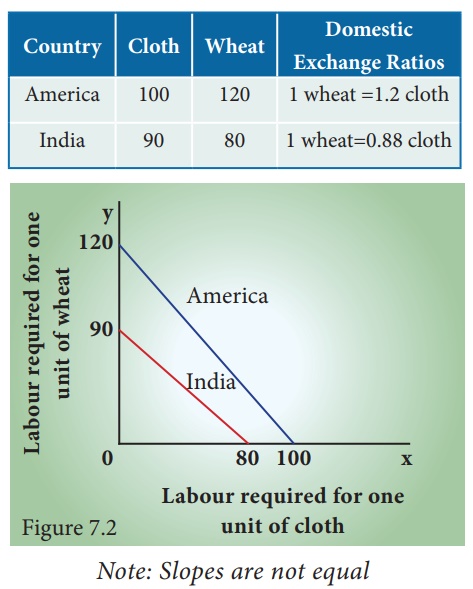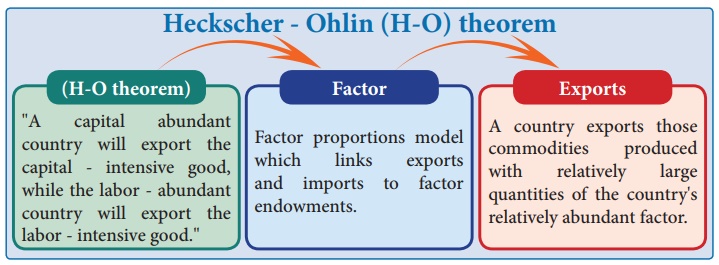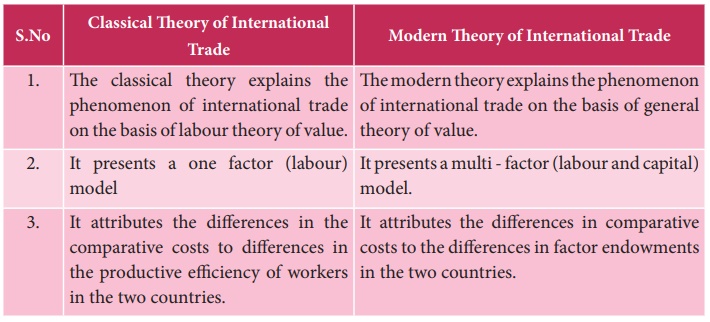International Economics - Theories of International Trade | 12th Economics : Chapter 7 : International Economics
Chapter: 12th Economics : Chapter 7 : International Economics
Theories of International Trade
Theories of International Trade
1. The Classical Theory of International Trade
Introduction
Adam Smith (1776) developed the theory of absolute cost advantage.
But it was David Ricardo who formulated as an explicit and precise theory,
namely, the theory of comparative cost advantage, which was later improved and
refined by the economists like J.S Mill, Cairnes, Bastable,Taussig and
Haberler. We shall first discuss the Adam Smith’s theory of absolute cost
advantage.
Classical Trade Theories
Mercantilism (pre - 16th century)
Takes an us-versus - them view of trade
Other country's gain is our country's loss
Free Trade theories
Absolute Advantage (Adam Smith,1776)
Comparative Advantage
(David Ricardo, 1817)
Specialization of production and free flow of goods benefit all
trading partner's economies
Free Trade refined
Factor - proporations (Heckscher - Ohlin, 1919)
International Product life (Ray Vernon, 1966)
2. Adam Smith’s Theory of Absolute Cost Advantage
Adam Smith argued that all nations can be benefitted when there is
free trade and specialisation in terms of their absolute cost advantage.
The Theory
According to Adam Smith, the basis of international trade was
absolute cost advantage. Trade between two countries would be mutually beneficial
when one country produces a commodity at an absolute cost advantage over the
other country which in turn produces another commodity at an absolute cost
advantage over the first country.
Assumptions
1. There are two countries and two commodities (2 x 2 model).
2. Labour is the only factor of production.
3. Labour units are homogeneous.
4. The cost or price of a commodity is measured by the amount of
labour required to produce it.
5. There is no transport cost.
Illustration
Absolute cost advantage theory can be illustrated with the help of
the following example.
Absolute Cost Advantage

From the illustration, it is clear that India has an absolute
advantage in the production of wheat over China and China has an absolute
advantage in the production of cloth over India. Therefore, India should
specialize in the production of wheat and import cloth from China. China should
specialize in the production of cloth and import wheat from India. This kind of
trade would be mutually beneficial to both India and China.
3. Ricardo’s Theory of Comparative Cost Advantage
David Ricardo , the British economist in his ‘Principles of
Political Economy and Taxation’ published in 1817, formulated a systematic
theory called ‘Comparative Cost Theory’. Later it was refined by J.S Mill,
Marshall, Taussig and others.
Ricardo demonstrates that the basis of trade is the comparative
cost difference. In other words, trade can take place even if the absolute cost
difference is absent but there is comparative cost difference.
According to Ricardo, a country can gain from trade when it
produces at relatively lower costs. Even when a country enjoys absolute
advantage in both goods, the country would specialize in the production and
export of those goods which are relatively more advantageous. Similarly, even
when a country has absolute disadvantage in production of both goods, the
country would specialize in production and export of the commodity in which it
is relatively less disadvantageous.
Assumptions
1.
There are only two nations and two commodities (2x2 model)
2.
Labour is the only element of cost of production.
3.
All labourers are of equal efficiency.
4.
Labour is perfectly mobile within the country but perfectly
immobile between countries.
5.
Production is subject to the law of constant returns.
6.
Foreign trade is free from all barriers.
7.
No change in technology.
8.
No transport cost.
9.
Perfect competition.
10. Full employment.
11. No government
intervention.
Illustration
Ricardo’s theory of comparative cost can be explained with a
hypothetical example of production costs of cloth and wheat in America and
India.
Comparative Cost Advantage
(Units of labour required to produce one unit)

It is evident from the example that India has an absolute
advantage in production of both cloth and wheat. However, India should
concentrate on the production of wheat in which she enjoys a comparative cost
advantage. (80/120 < 90/100). For America the comparative cost disadvantage
is lesser in cloth production. Hence America will specialize in the production
of cloth and export it to India in exchange for wheat. (Any exchange ratio
between 0.88 units and 1.2 units of cloth against one unit of wheat represents
gain for both the nations). With trade, India can get 1 unit of cloth and 1
unit of wheat by using its 160 labour units. In the absence of trade, for
getting this benefit, India will have to use 170 units of labour. America also
gains from this trade. With trade, America can get 1 unit of cloth and one unit
of wheat by using its 200 units of labour. Otherwise, America will have to use
220 units of labour for getting 1 unit of cloth and 1 unit of wheat.
Criticisms
1. Labour cost is a small portion of the total cost. Hence, theory
based on labour cost is unrealistic.
2. Labourers in different countries are not equal in efficiency.
4. Modern Theory of International Trade
Introduction
The modern theory of international trade was developed by Swedish
economist Eli Heckscher and his student Bertil Ohlin in 1919. This model was
based on the Ricardian theory of international trade. This theory says that the
basis for international trade is the difference in factor endowments. It is
otherwise called as ‘Factor Endowment Theory’.
Factor endowment model
Developed by Heckscher and Ohlin
Countries with
a relative factor abundance
can specialise and trade
Abundance of skilled labour
→ specialisation →
export → exchange for goods are
services produced by countries with
abundance of unskilled labour
Exports embody the abundant factor
Imports embody the scarce factor
Assumes a high degree of factor mobility
The Theory
The classical theory argued that the basis for foreign trade was
comparative cost difference and it considered only labour factor. But the
modern theory of international trade explains the causes for such comparative
cost difference. This theory attributes international differences in
comparative costs to:
i) difference in the endowments of factors of production between
countries, and
ii) differences in the factor proportions required in production.
Assumptions
1. There are two countries, two commodities and two factors.
(2x2x2 model)
2. Countries differ in factor endowments.
3. Commodities are categorized in terms of factor intensity.
4. Countries use same production technology.
5. Countries have identical demand conditions.
6. There is perfect competition in both product and factor
markets in both the countries.

Explanation
According to Heckscher - Ohlin, “a capital-abundant country will
export the capital –intensive goods, while the labour-abundant country will
export the labour-intensive goods”. A factor is regarded abundant or scare in
relation to the quantum of other factors. A country can be regarded as richly
endowed with capital only if the ratio of capital to other factors is higher than
other countries.
Illustration

In the above example, even though India has more capital in
absolute terms, America is more richly endowed with capital because the ratio
of capital in India is 0.8 which is less than that in America where it is 1.25.
The following diagram illustrates the pattern of word trade.

Limitations
1. Factor endowment of a country may change over time.
2. The efficiency of the same factor (say labour) may differ in
the two countries. For example, America may be labour scarce in terms of number
of workers. But in terms of efficiency, the total labour may be larger.
5. Comparison of Classical Theory and Modern Theory

Classical Theory of International Trade
1. The classical theory explains the phenomenon of international
trade on the basis of labour theory of value.
2. It presents a one factor (labour) model
3. It attributes the differences in the comparative costs to
differences in the productive efficiency of workers in the two countries.
Modern Theory of International Trade
1. The modern theory explains the phenomenon of international
trade on the basis of general theory of value.
2. It presents a multi - factor (labour and capital) model.
3. It attributes the differences in comparative costs to the
differences in factor endowments in the two countries.
Related Topics